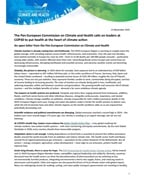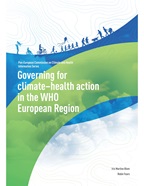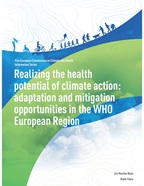Heatwaves
The WHO European Region is the fastest warming of the 6 WHO regions, with temperatures rising at around twice the global average rate. The 3 warmest years on record for the Region have all occurred since 2020, and the 10 warmest years have been since 2007.
Heat stress is the leading cause of climate-related death in the Region. Over the past 20 years, there has been a 30% increase in heat-related mortality, with heat-related deaths estimated to have increased in almost all of the countries of the Region where monitoring is in place. Over the past 30 years, the hours of heat-stress risk for physical activity have spread beyond the hottest parts of the day. This shift may result in a reduction in overall physical activity, which in turn may increase the risk of noncommunicable diseases.
The frequency, intensity and duration of heatwaves, as well as other extreme weather events, are all expected to increase in the coming decades. This makes it even more important for individuals and communities to understand the risks and how to be prepared, and for health systems and societies to adapt to the changing climate.
Heat is a growing health risk due to burgeoning urbanization, an increase in high-temperature extremes and demographic changes in countries with ageing populations, like most Member States of the WHO European Region.
Heatwaves across the Region are affecting the health and livelihoods of millions of people and climate change is increasing the risk of them occurring. Extreme heat in the summer months is becoming the norm, not the exception. In 35 countries of the Region, heat claimed more than 60 000 lives in 2022 and 47 500 lives in 2023. By 2050, with no further adaptation, this could rise to 120 000 heat-related deaths every year in the Region.
Heat can trigger exhaustion and heat stroke, and can exacerbate existing medical conditions, including diabetes, and cardiovascular, respiratory and cerebrovascular diseases, and aggravate mental health problems. Particularly at risk are older people, infants, people who work outdoors and those who are chronically ill. Heat can also place an additional burden on pregnant women.
The adverse health effects of hot weather are largely preventable through good public health practices.
WHO works with countries bringing together actors from multiple sectors to develop heat–health guidance, both for authorities preparing for and responding to hot weather, and the general public, in the form of health advice. Its work – in particular through the WHO European Centre for Environment and Health (Bonn, Germany) – provides the most up-to-date evidence-based point of reference for national and local governments to establish their own plans or update existing ones.
Preventing adverse heat-related health outcomes requires a portfolio of actions at different levels. These actions can be integrated into a systematic public health response, known as a heat–health action plan. Furthermore, a range of risk communication, awareness and advocacy strategies can help inform communities, decision-makers and individuals about how to reduce heat risks during hot weather and adapt society to a hotter future.
Measures to adapt to future extreme heatwaves include:
- heat–health action plans that incorporate early-warning and response systems for urban and non-urban settings;
- response strategies targeting both the general population and vulnerable groups such as older adults and people who work outside; and
- effective stakeholder communication plans.
Heat–health action plans are crucial to adaptation to climate change, protecting communities from heat-related death and disease. More than 20 countries in the Region have heat–health action plans in place. While this is encouraging, it is not enough to protect all communities. For the plans to be effective, we need strong intersectoral coordination and cooperation.












